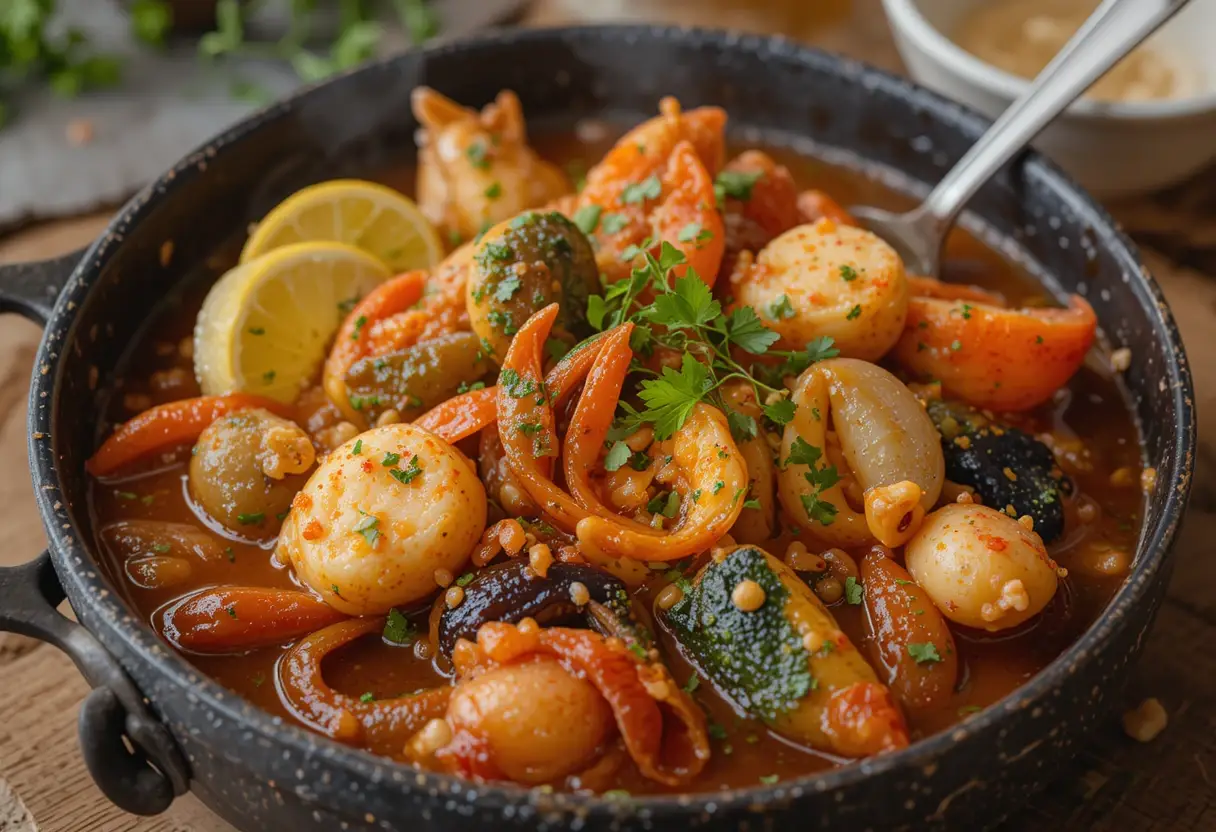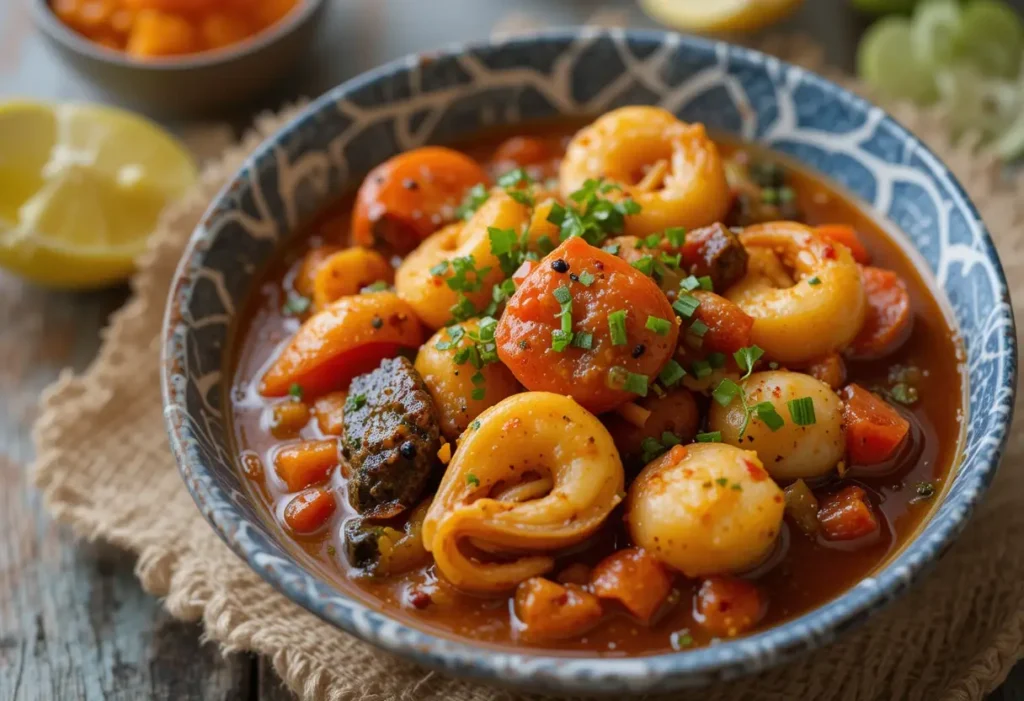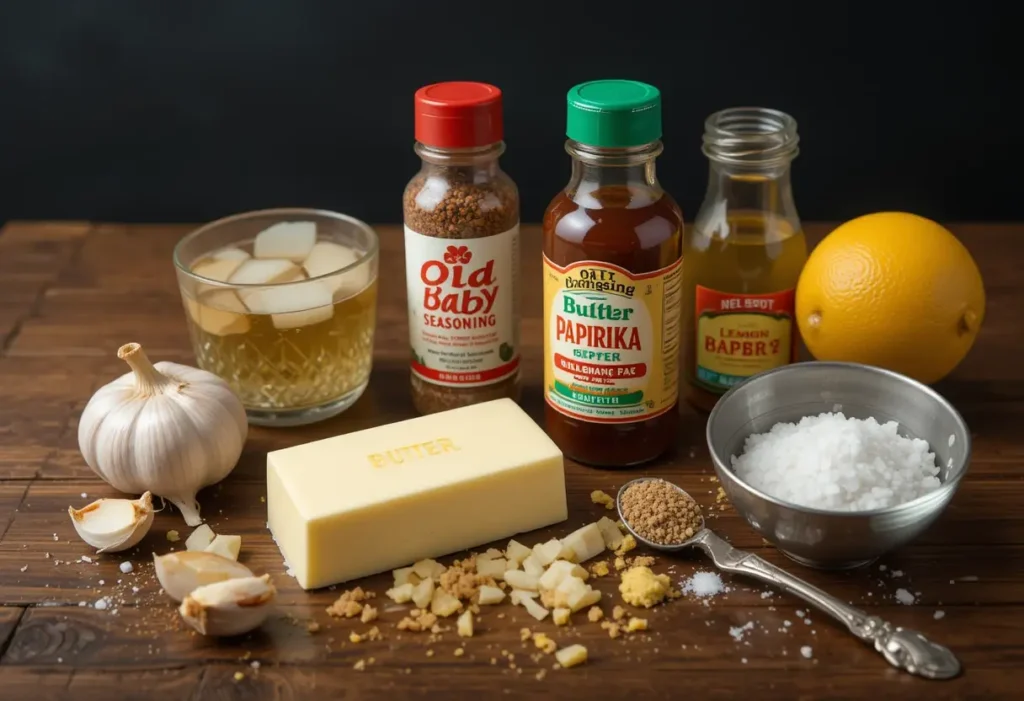Seafood boils sauce recipe have long been a cherished tradition in coastal communities and beyond. They bring people together with their vibrant colors, mouthwatering aromas, and an unmatched mix of seafood flavors. Whether it’s a family gathering, a celebratory event, or a weekend indulgence, a seafood boil offers a hearty meal that satisfies both the taste buds and the soul.
But what truly elevates a seafood boil from a delicious meal to an unforgettable experience? It’s the sauce. The seafood boil sauce is the heart and soul of this culinary tradition, tying together the flavors of shrimp, crab, lobster, clams, and other seafood. A great sauce complements the natural sweetness of the seafood while adding layers of spice, tanginess, and depth that leave you craving more.
Overview of Seafood Boil Importance
At its core, a seafood boil is more than just food it’s an experience. Rooted in traditions like Cajun and Lowcountry cooking, this dish has become a symbol of community, celebration, and flavor. The seafood boil itself is a culinary masterpiece, combining a medley of fresh seafood, vegetables, and spices. However, its success relies on balance: the fresh ingredients, the proper cooking method, and the perfect sauce.
The Essence of a Good Seafood Boil Sauce
A good seafood boil sauce does more than add flavor; it creates harmony. It acts as a bridge between the diverse textures and flavors of seafood, ensuring every bite is perfectly seasoned. A well-made sauce should have a balance of buttery richness, aromatic spices, and a hint of heat. Garlic, lemon, paprika, cayenne, and Old Bay seasoning are popular staples, but the best sauces also leave room for personal touches and regional twists.
The sauce clings to every piece of seafood, enhancing the taste of crab legs, shrimp, or lobster tails. It also adds a flavorful punch to the vegetables, corn, and potatoes simmered alongside the seafood. The result is a feast that’s as satisfying to eat as it is to share.
Ingredients for Seafood Boil Sauce
A delectable seafood boil sauce starts with high-quality ingredients that bring out the best in the seafood. This section provides a comprehensive list of essential ingredients and optional add-ins to help you customize your sauce for the perfect flavor.
Table of contents
Essential Ingredients for Seafood Boil Sauce
- Butter: The base of any good seafood boil sauce. Butter provides richness and helps the sauce adhere to the seafood.
- Garlic: Freshly minced garlic adds an aromatic punch that complements the seafood’s natural sweetness.
- Old Bay Seasoning: A quintessential spice blend that delivers the classic seafood boil flavor.
- Paprika: Adds depth and a mild smokiness to the sauce.
- Cayenne Pepper: For that signature heat, cayenne pepper is a must. Adjust the quantity based on your spice tolerance.
- Lemon Juice: Brightens the sauce with its tangy freshness.
- Salt and Black Pepper: Enhances the overall flavor profile.
- Chicken or Seafood Broth: Adds a savory base and helps achieve the right consistency.
Optional Ingredients for Customization
For those looking to personalize their seafood boil sauce, here are some additional ingredients that can add unique flavors and textures:
- Honey or Brown Sugar: To balance the heat with a touch of sweetness.
- Hot Sauce: For an extra kick of heat and tanginess.
- Worcestershire Sauce: Adds a rich, umami depth to the sauce.
- Chopped Fresh Herbs: Parsley, cilantro, or dill can introduce a fresh and herbal note.
- Crushed Red Pepper Flakes: Perfect for those who love bold spiciness.
- White Wine: Adds a touch of elegance and enhances the sauce’s complexity.
- Smoked Paprika: For a stronger smoky flavor.
Whether you prefer a traditional sauce or one with a modern twist, experimenting with these ingredients ensures you’ll find a combination that perfectly matches your taste preferences.
Step-by-Step Cooking Guide
Crafting the perfect seafood boil sauce requires a careful balance of preparation, cooking technique, and attention to detail. Follow this step-by-step guide to create a flavorful sauce that will take your seafood boil to the next level.
Preparing Your Ingredients
- Gather Your Ingredients: Ensure all your essential and optional ingredients are on hand. Measure them out to streamline the cooking process.
- Chop and Mince: Finely mince garlic, chop fresh herbs if using, and have all seasonings within reach.
- Melt the Butter: Use unsalted butter for better control over the sauce’s saltiness. Cut it into chunks for easier melting.
- Prepare the Broth: Warm your chicken or seafood broth to prevent sudden temperature changes when adding it to the sauce.
Cooking the Sauce: Phase 1
- Melt the Butter: In a medium-sized saucepan over medium heat, melt the butter until it’s fully liquid but not browned.
- Add Garlic: Stir in the minced garlic and sauté for 1-2 minutes until fragrant. Be careful not to let it burn.
- Incorporate Spices: Add Old Bay seasoning, paprika, cayenne pepper, and a pinch of salt. Stir well to coat the garlic and butter evenly with spices.
- Add Liquid Components: Slowly pour in the warm chicken or seafood broth and lemon juice. Stir continuously to blend the flavors.
- Simmer: Reduce the heat to low and let the sauce simmer for about 5-7 minutes, allowing the ingredients to meld together.
Adding Seafood and Final Touches
- Taste and Adjust: Before combining the sauce with your seafood, taste and adjust the seasoning. Add more cayenne for heat or lemon juice for brightness.
- Combine with Seafood: Once your seafood boil is ready, pour the sauce over the seafood mixture in a large bowl or directly into the pot. Toss thoroughly to ensure every piece is coated.
- Optional Garnishes: Sprinkle chopped fresh herbs, a dash of smoked paprika, or a drizzle of hot sauce for a finishing touch.
- Serve Immediately: Serve your seafood boil hot with plenty of napkins, as it’s sure to be a messy yet delightful feast!
Cooking tip: To ensure an even coating of sauce, toss the seafood and sauce together in small batches, especially if you’re cooking for a crowd. This guarantees that every bite is bursting with flavor.
Variations of Seafood Boil Sauce
While the classic seafood boil sauce is delicious on its own, experimenting with variations can elevate your culinary experience. Here are three exciting versions of seafood boil sauce to suit different flavor preferences:
Spicy Version
If you love heat, this version is for you. Enhance the spice level by incorporating additional ingredients:
- Ingredients to Add: Extra cayenne pepper, hot sauce, and crushed red pepper flakes.
- Cooking Tip: Sauté the spices in butter for a few seconds before adding garlic to intensify their flavors.
- Perfect Pairing: Spicy sauce pairs wonderfully with robust seafood like crawfish, shrimp, and lobster.
Herby Version
For a fresh and earthy take, create a herby seafood boil sauce:
- Ingredients to Add: Freshly chopped parsley, cilantro, dill, and thyme.
- Cooking Tip: Add the fresh herbs at the very end to preserve their aroma and vibrant color.
- Perfect Pairing: This version works best with lighter seafood like scallops, clams, and mussels.
Citrus-Infused Version
Brighten the flavors of your seafood boil with a citrus-infused sauce:
- Ingredients to Add: Zest and juice of lemons, limes, and oranges.
- Cooking Tip: Add the zest during the cooking process and the juice just before serving for the freshest taste.
- Perfect Pairing: The citrus version complements crab, lobster, and shrimp, enhancing their natural sweetness.
Pairing with Seafood
A good seafood boil sauce isn’t complete without perfectly prepared seafood. Choosing the right seafood and ensuring it’s cooked to perfection is key to creating a memorable meal.
Best Seafood for This Sauce
- Shrimp: Its natural sweetness and tender texture make it an all-time favorite. Try this shrimp recipe for inspiration.
- Crab: Both king crab and snow crab pair well with rich, buttery sauces. Learn how to prepare crab-based dishes.
- Lobster: This luxurious seafood shines with a flavorful sauce that complements its succulence.
- Crawfish: A classic choice for Cajun-style seafood boils.
- Clams and Mussels: Their briny flavor is enhanced by the bold sauce.
- Scallops: A delicate option that absorbs the sauce beautifully.
Preparation Tips for Seafood
- Freshness First: Use the freshest seafood available to ensure the best flavor. Frozen seafood can work but should be thoroughly thawed.
- Proper Cleaning: Rinse seafood like shrimp, clams, and mussels to remove grit or impurities. Devein shrimp and scrub shellfish.
- Season the Boil Water: Before adding the seafood, season the boiling water with salt, spices, and aromatics like bay leaves, garlic, and onions. This step infuses the seafood with flavor before it’s even coated in sauce.
- Cook in Stages: Add seafood to the boiling pot in order of cooking time. For example, start with clams and mussels (which take longer), then add shrimp and crab towards the end.
- Don’t Overcook: Overcooking makes seafood rubbery. Pay attention to cooking times—shrimp, for instance, only need 2-3 minutes.
By pairing the right seafood with your sauce and preparing it thoughtfully, you can create a seafood boil feast that’s bursting with flavor and texture.
Nutritional Information
A seafood boil sauce is flavorful and indulgent, but it’s also worth understanding its nutritional profile. Here’s a breakdown of its caloric content and the health benefits of its ingredients.
Caloric Content Per Serving
The caloric content of a seafood boil sauce depends on the ingredients and serving size. On average:
- Butter: Each tablespoon contains about 100 calories. Learn how to use butter in different recipes.
- Garlic: Adds minimal calories, roughly 5 per clove. Explore garlic-rich recipes like these shrimp burritos.
- Seasonings: Old Bay, cayenne, and paprika contribute negligible calories but pack bold flavors.
- Chicken or Seafood Broth: Typically adds 5-10 calories per cup. Discover the benefits of homemade broths.
- Lemon Juice: Only 4-6 calories per tablespoon. See its use in refreshing dishes like salmon recipes.
A standard serving of sauce (about 2-3 tablespoons) contains approximately 150-200 calories, making it a rich addition to a seafood boil.
Health Benefits of Ingredients
Despite its richness, seafood boil sauce includes ingredients with notable nutritional benefits:
- Garlic: Rich in antioxidants and known for its heart-healthy properties.
- Lemon Juice: High in vitamin C, supporting immunity and digestion.
- Paprika: Contains antioxidants and vitamins A and E, promoting skin and eye health.
- Cayenne Pepper: Boosts metabolism and may have anti-inflammatory benefits.
- Seafood Broth: Provides essential minerals like iodine and calcium.
Learn how these ingredients enhance dishes like vegetarian lasagna soup.
Storage and Reuse
Seafood boil sauce is so delicious that you’ll want to save every last drop. Here’s how to store it properly and creatively reuse it in other recipes.
How to Store Leftover Sauce
- Refrigeration: Let the sauce cool to room temperature, then store it in an airtight container. It will keep in the refrigerator for up to 3 days.
- Freezing: Transfer the cooled sauce to a freezer-safe container or ice cube trays. It can be frozen for up to 3 months. Thaw in the fridge overnight before reheating.
Ideas for Using Leftover Sauce
- Pasta: Toss the sauce with cooked pasta and a sprinkle of Parmesan for a quick seafood-inspired meal. Try it with these cheesy rice recipes.
- Vegetable Drizzle: Use it to flavor steamed or roasted vegetables like broccoli, asparagus, or corn.
- Rice or Grain Bowls: Add the sauce to rice, quinoa, or couscous for a flavorful side dish.
- Marinade: Repurpose it as a marinade for chicken, fish, or shrimp before grilling. Get inspired by this chicken couscous dish.
- Dipping Sauce: Use it as a dip for bread, fries, or roasted potatoes.
Common Mistakes and Solutions
Even seasoned cooks can make mistakes when preparing a seafood boil sauce. Here are common pitfalls and how to fix them:
Overseasoning
- Problem: The sauce is too salty or spicy.
- Solution:
- Dilute the sauce with additional butter, broth, or water.
- Add a splash of cream to mellow out strong flavors.
Timing the Seafood Addition
- Problem: Seafood becomes overcooked or under cooked.
- Solution:
- Under-cooking: Extend cooking time by 1-2 minutes while checking frequently.
- Over-cooking: Remove seafood from the pot immediately and plunge it into an ice bath to stop the cooking process.
tly create a seafood boil sauce that’s both delicious and foolproof!
FAQs
What is the best seafood to use for a seafood boil?
The best seafood depends on your preferences and availability, but popular choices include shrimp, crab (king or snow), lobster, crawfish, mussels, clams, and scallops. These seafood types pair well with the rich flavors of a seafood boil sauce and offer a variety of textures. For a well-rounded boil, include a mix of shellfish and crustaceans.
How can I make my seafood boil sauce spicier?
To turn up the heat, add more cayenne pepper, crushed red pepper flakes, or your favorite hot sauce. You can also incorporate spicy seasonings like chili powder or extra Old Bay seasoning. Be sure to taste as you go to avoid overwhelming the sauce.
What are the key ingredients in a seafood boil sauce?
The essential ingredients for a seafood boil sauce include butter, garlic, Old Bay seasoning, paprika, cayenne pepper, lemon juice, and broth (chicken or seafood). Optional additions like hot sauce, Worcestershire sauce, herbs, and honey can enhance the flavor and personalize your sauce.
How long can I store the seafood boil sauce in the fridge?
Seafood boil sauce can be stored in an airtight container in the refrigerator for up to 3 days. Make sure it’s fully cooled before storing, and reheat gently on the stovetop or microwave before using.
Can I prepare the seafood boil sauce ahead of time?
Yes, the sauce can be made a day or two in advance. Store it in the fridge and reheat before serving. For best results, whisk the sauce while reheating to ensure it maintains its creamy consistency.
Are there any alternatives to traditional seafood in a seafood boil?
If seafood isn’t an option, you can create a similar boil using proteins like chicken, sausage, or even plant-based alternatives like tofu or jackfruit. Pair these with corn, potatoes, and vegetables to replicate the essence of a seafood boil.
Conclusion
A seafood boil is more than just a meal; it’s an experience that brings people together around a table filled with vibrant flavors and irresistible aromas. The true magic lies in the seafood boil sauce, which enhances every bite with its perfect balance of spices, richness, and tang. By mastering the ingredients, cooking techniques, and optional customizations, you can create a sauce that’s uniquely yours. Whether hosting a family feast or enjoying a casual dinner, this sauce ensures your seafood boil will be a memorable culinary delight. Dive into the tradition and savor every flavorful moment!
Seafood Boil Sauce Recipe: Ultimate Flavors Unleashed
Ingredients
- 1 cup 2 sticks unsalted butter
- 1 medium onion finely chopped
- 10 cloves garlic minced
- 1 tablespoon Old Bay seasoning
- 1 tablespoon smoked paprika
- 1 tablespoon lemon pepper seasoning
- 1 teaspoon cayenne pepper adjust to taste
- 1 teaspoon red pepper flakes
- 1 tablespoon brown sugar
- 1 tablespoon Worcestershire sauce
- 2 tablespoons hot sauce such as Tabasco
- 1 cup seafood or chicken broth
- 2 tablespoons fresh lemon juice
- Salt and freshly ground black pepper to taste
- 2 tablespoons fresh parsley chopped (for garnish)
Instructions
- In a large saucepan over medium heat, melt the butter. Add the chopped onion and sauté until translucent, about 5 minutes.
- Add the minced garlic and cook for an additional 2 minutes, stirring frequently to prevent burning.
- Stir in the Old Bay seasoning, smoked paprika, lemon pepper seasoning, cayenne pepper, red pepper flakes, and brown sugar. Cook for 1-2 minutes until the spices are fragrant.
- Pour in the Worcestershire sauce, hot sauce, seafood or chicken broth, and lemon juice. Stir to combine and bring the mixture to a simmer.
- Reduce the heat to low and let the sauce simmer for 10-15 minutes, allowing the flavors to meld together. Stir occasionally.
- Taste and adjust seasoning with salt and freshly ground black pepper as needed.
- Remove from heat and garnish with chopped fresh parsley.
- Serve the sauce warm alongside your favorite seafood boil ingredients, such as shrimp, crab legs, corn on the cob, and potatoes.
Notes
- Balance the Heat: Adjust the cayenne pepper and red pepper flakes to your spice preference. If you prefer a milder sauce, start with half the amount and gradually increase as needed.
- Enhance the Depth: For an extra rich and umami-packed sauce, consider adding a teaspoon of seafood bouillon or a splash of white wine while simmering.
- Perfect the Consistency: If the sauce is too thick, add a little more broth or lemon juice. If it’s too thin, let it simmer for an extra few minutes until it reaches the desired consistency.



